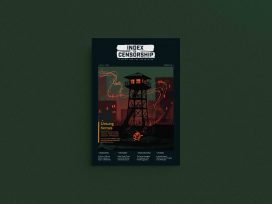In this year’s volumes of Dialogi, which concludes with this issue, we have published several articles on the media. Thanks to the efforts of my colleague Boris Vezjak, the summer issue opened up the major topic of media censorship in Slovenia. This was during a time when the Slovenian media was silent on censorship and the difficulties faced by journalists, and hence the publication of this thematic issue of Dialogi also went largely without comment from the majority of the media. That which was once called censorship is today happening as part of “democratic” decision-making by journalists and editors about what is to be reported on and what is not. And if the media does not write or talk about some event or some person, then in media society, this event or person simply does not exist.
The problem of reporting, or not reporting, something also heavily impacts on Slovenian culture. Certain segments of culture do not even penetrate the media, or do so only with great difficulty. For example, where theatre production receives fairly decent coverage, the bulk of interesting and high quality book production is effectively ignored. The commercialization of the media has had a powerful influence on cultural reporting, since it requires writing mainly about events which attract a large number of readers, viewers, and listeners. Reporting on culture by commercial media has reduced it to a “scene”. Thus a report on some theatrical production does not involve a professional critique, but is rather a social chronicle after the conclusion of the event. This type of reporting on culture is becoming increasingly prominent even on the pages of supposedly serious newspapers. In this way, it can happen that on the same day the same newspaper reports on the same cultural event in completely different ways on different pages. For example, after a ballet premiere we might find photos of various local VIPs in the company of various lovely ladies, glasses in hand, on the society page. The journalist writing the accompanying text offers up a one-sentence report along the lines of “it was charming.” Meanwhile, on the culture page, an authoritative critic trashes the same performance with a devastatingly well-argued critique. In the same newspaper the reader thus encounters two completely different evaluations of an event: one conveys the message that it was charming, attended by the cream of society, and therefore very significant, while the other indicates that the performance was a poor one. We know which page has more readers. Some Slovenian artists long ago figured out that this kind of appearance at a “scene” serves as an excellent means of self-promotion. In this way more people learn who they are, their names become widely recognized, including to the national and local political personalities who finance their projects, and they also become better known to potential sponsors. If, at the same time, they are surrounded by journalists and editors inclined to report favourably on the event, this proves to be an excellent investment.
But let’s restrict ourselves to a specific local scene. The Maribor newspaper Vecher, as the main print media locally, has several constants in its reporting on culture, which according to the judgment of their editorial board are deserving of special attention outside the cultural pages. These are cultural events which already have a sufficiently long tradition and at which members of the social elite gather (e.g. the Borshtnik meeting theatre festival) or which are aimed at mass audiences and go beyond just culture (e.g. the Lent Festival). Then there are a few other running themes on its pages, for example the undying nostalgia for the Obzorja publishing house, and more recently, of course, the European Capital of Culture project. Vecher also has its favourite cultural personalities. Without a doubt the top spot in this category goes to Tomaz Pandur. During his golden era at the Maribor Drama, in the first half of the 1990s, Pandur was a darling of the local media, which found him hugely charming and fascinating. More critical voices were for the most part kept out of the media, hence they might as well not have existed. At the end of his directorship of the Maribor Drama coverage of his activities did move from the culture and society pages to those devoted to crime reporting, but after Pandur’s flight abroad, Vecher would merely publish some piece of news about him here and there. Vecher did not publish excerpts from critical reviews of his performances abroad, and any debate about the artistic merits of his projects was missing. A professional critic had this to say: “And so it happened that Tomaz Pandur, after his infamous departure from the Maribor theatre in 1996, was on the one hand regarded as a “dissident” hero of the new age, and on the other as a common fraudster; any definition of his true image and influence is strongly avoided by the Slovenian theatre and cultural public.” (Blaz Lukan: Tihozitja in grimase/Still lifes and grimaces. 2007, p. 161). And it was precisely into this undefined space that Pandur returned this past spring, with the help of – the media. The now ex-director of Vecher, Milan Predan, argued in favour of the unusual media sponsorship by his organization of the visit by the Pandur Theaters group for a performance of the Tesla Electric Company in the Slovenian National Theatre in Maribor by emphasizing the need to put the phenomenal Pandur in the place where he belongs. I cannot remember a time when the Slovenian media ever orchestrated a campaign to financially support and promote a person or project with a precisely defined aim. This aim is Pandur’s inclusion in the Maribor – European Capital of Culture 2012 project. Vecher‘s construction of reality was complete: from the numerous announcements and press conferences to the big interview, raffling of free theatre tickets to readers, and a glossy theatre programme as a free supplement to the newspaper.
We will not involve ourselves here in the critical arguments for and against Pandur’s theatre. We simply wonder what it is about his theatre that so attracts a certain social stratum and how that theatre functions in society.
When Pandur’s tenure at the Maribor Drama began in 1990 with a performance of Faust, a new type of public began flocking to the foyers of the Slovenian National Theatre in Maribor (even as some others stopped going there). We referred to them, in the slang of our generation, as shminkerji, snobi, and hohshtaplerji, (pretty boys, snobs, and poseurs), otherwise covered by the emergence of the so-called nouveaux riches within the newly stratified society. Pandur directed his dreamlike performances in a time when Maribor’s economy was collapsing and its workers were being pushed to the margins of society. In this impoverished environment, a thin social layer of newly rich wanted glitter, glamour, wealth and space for themselves. The Maribor theatre is, now that it has been renovated and expanded, the only space in the city where members of the Maribor (petit) bourgeois can show themselves in their best finery, and where there is no risk of encountering the anxious faces of the poor who otherwise walk the streets of their city. The premises of the theatre are so glamorous and representative that political VIPs from the capital also like to frequent them, especially during election campaigns.
Pandur’s theatre is of course not political in its content, but it has its immanent artistic world which is displayed in rich, extravagant visual images, which as theatrical metaphors are often incomprehensible in the context of the content, especially in connection with the pathetically spoken, freely assembled text. This theatre frequently chooses as its material grand, well-known and timeless themes and personalities (Faust, Hamlet, Carmen, Divine Comedy, Tesla, etc.). Based on this basic principle, the Pandur theatre has remained the same throughout and is still so today, when Slovenian theatre after a long period of self-reflection with the performances of director Sebastjan Horvat experienced a breakthrough into a new, provocative, and politically engaged direction. Horvat’s provocative approach grabs the public into its magic circle, causes it to become uncomfortable or emotionally euphoric, and by all means forces it to think about the contemporary social moment. This cannot happen to the public at Pandur’s theatre, since it does not deal with contemporary social problems. The public remains aware for the entire time that it is at a performance which offers primarily a purely aesthetic pleasure which charms and solicits admiration. This kind of art can be shown to anyone, as if to say, we too can produce extravagance and glamour. And this kind of art is representatively useful for politics as well.
For individual cities, the European Capital of Culture as a political project of the EU is often a plaster on their wounds. If neighbouring Graz in 2003 healed its inferiority complex in comparison with the dominant Vienna with the slogan “Graz – who would have guessed!”, it appears from the media support of the return of Tomaz Pandur to Maribor that the latter will cure its complex as a poor city with uncertain prospects with the inclusion of a Pandurian spectacle in the program of the European Capital of Culture.
As to whether this medicine is the right prescription, we’ll have occasion to make that judgment in the future …






